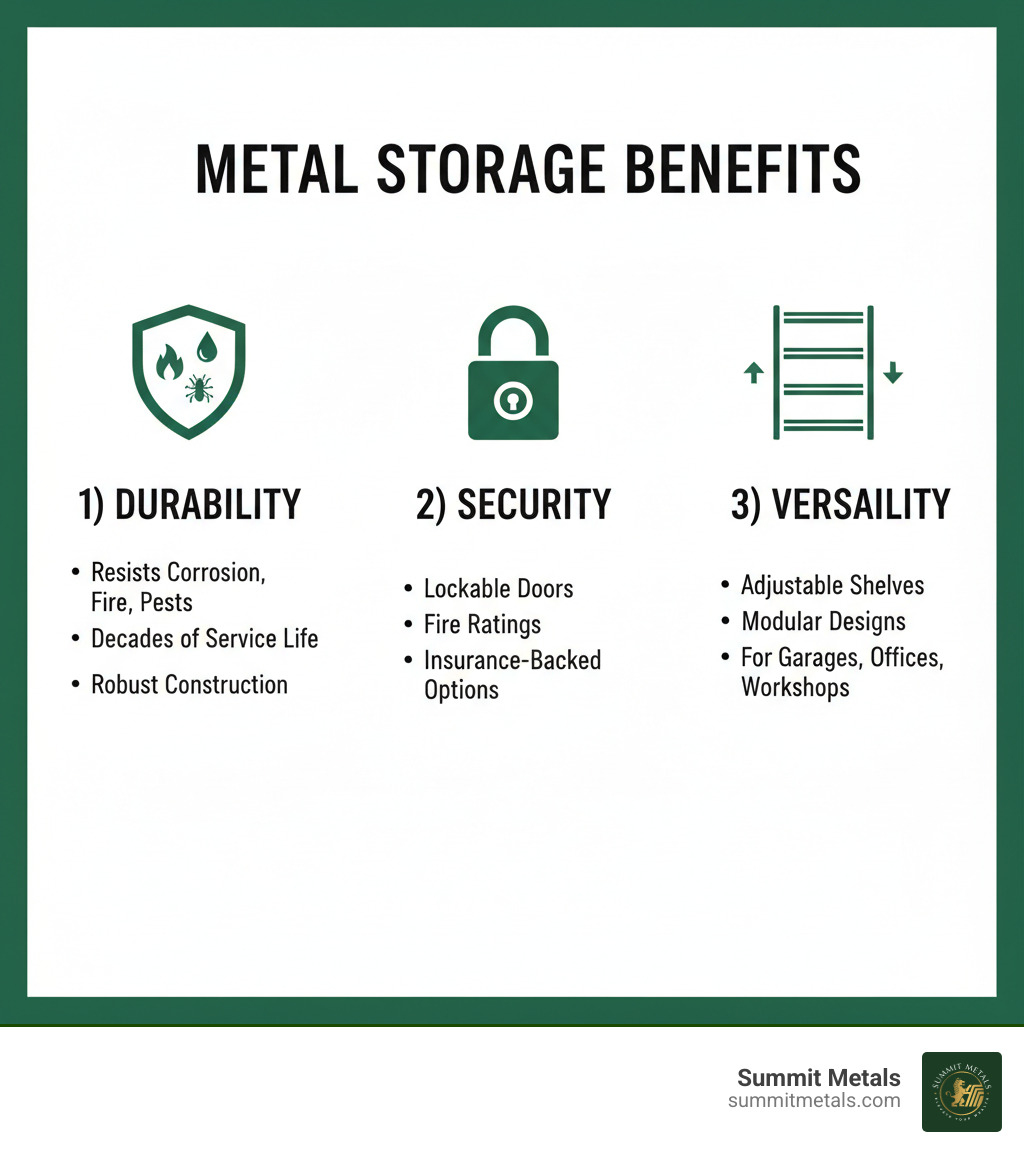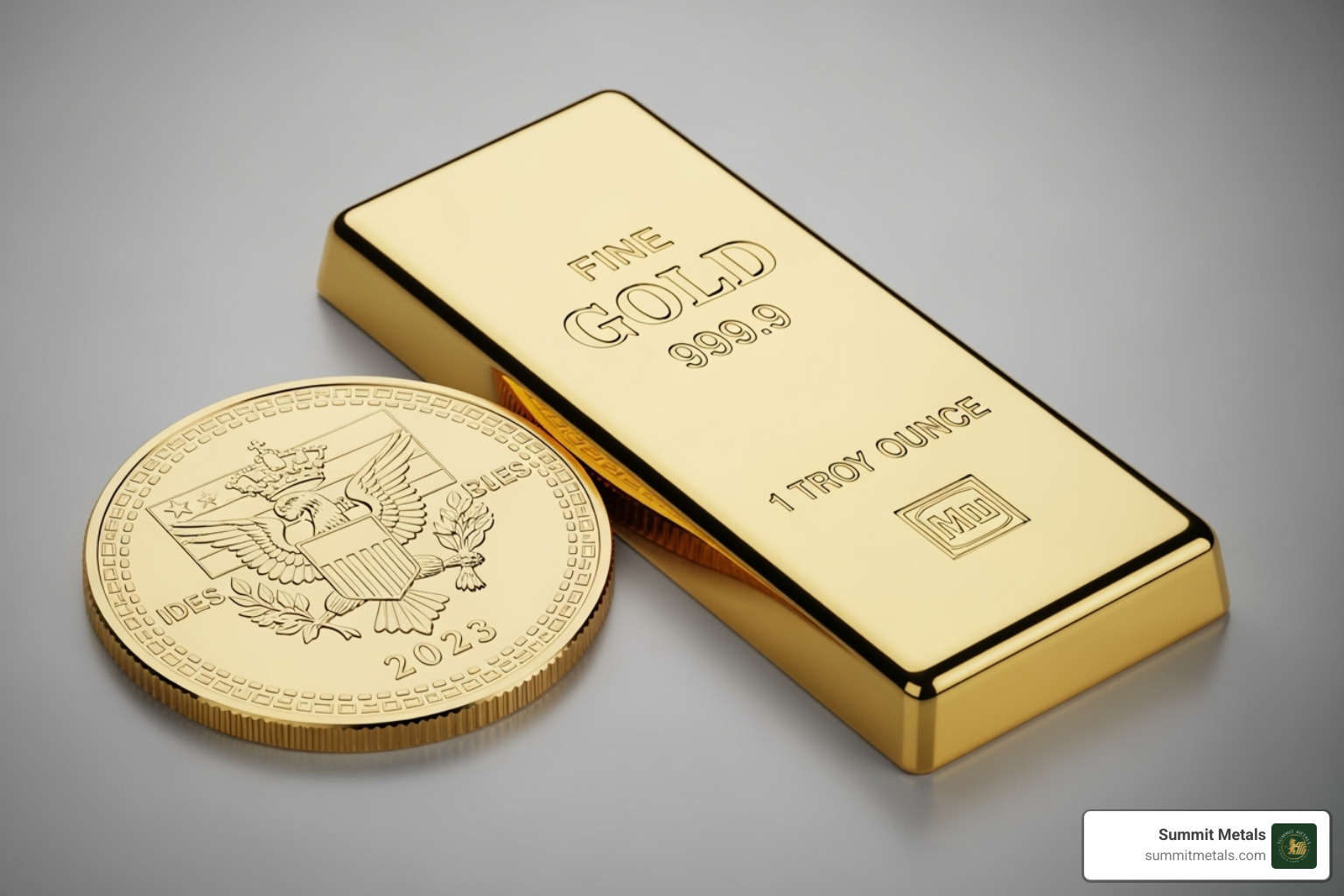Understanding Metal Storage: From Cabinets to Precious Metal Vaults
Metal storage refers to any durable container, cabinet, safe, or facility designed to organize and protect your belongings—from everyday tools to investment-grade precious metals. The market for these solutions is robust, with the metal storage cabinet sector alone projected to reach $2.3 billion by 2032.
What metal storage includes:
- Home & garage solutions – Heavy-duty cabinets, tool chests, wall-mounted units
- Office & commercial – File cabinets, lockers, shelving systems
- High-security options – Fire-rated safes, precious metal depositories
- Specialized containers – Tubes and boxes for coins, bars, and bullion
Whether decluttering a workshop or securing a precious metals portfolio, metal storage offers superior durability, security, and versatility. Metal resists fire and pests, outlasts wood or plastic, and often features lockable doors and adjustable shelves. For high-value assets, specialized safes and third-party depositories provide insurance, segregated storage, and IRS-compliant custody.
This guide covers the benefits of metal storage, how to choose the right type for your needs, and best practices for protecting everything from power tools to gold coins. You'll also see how dollar-cost averaging through programs like Summit Metals' Autopay makes it easy to build a precious metals portfolio, similar to contributing to a 401(k).
I'm Eric Roach. After a decade on Wall Street advising on institutional bullion strategies, I now help everyday investors protect their wealth with the same disciplined approach to precious metals security.

The Best Benefits of Metal Storage Solutions
Whether you're organizing a garage, an office, or protecting valuable assets, metal storage offers a straightforward solution that works better than alternatives. The difference comes down to three core advantages: durability, security, and versatility.
Durability is where metal truly separates itself from the pack. A well-built metal cabinet is tough. Unlike plastic that can crack under weight, a quality metal unit can handle heavy loads with confidence. We've seen metal shelving systems rated for up to 240 pounds per shelf, providing peace of mind whether you're storing automotive parts, files, or inventory.
This strength translates to exceptional longevity. Wood warps and plastic becomes brittle, but metal performs for decades. It resists rot, cracks from temperature swings, and maintains its structural integrity through conditions that would destroy other materials. An investment in metal storage is often a one-time purchase that can last a lifetime.
Security is a compelling reason to choose metal, especially for valuable items. A flimsy cabinet offers little protection, but metal storage with lockable options creates a real barrier. This is crucial for securing expensive tools, confidential files, or personal items. The integrated locking mechanisms on modern metal cabinets are designed to keep your belongings safe.
Beyond theft, metal offers impressive fire and pest resistance. While not entirely fireproof, metal significantly slows the spread of flames, protecting contents during a fire's critical early minutes. It also provides an impenetrable barrier to rodents and insects that would chew through cardboard or wood.
Finally, the versatility and organization of metal storage are remarkable. Most units feature adjustable shelves, allowing you to customize the interior as your needs change. This flexibility ensures your storage system evolves with you. Metal storage works equally well for home use (basements, closets), office use (file cabinets), and commercial spaces (retail inventory, restaurant supplies). Companies like Metro Shelving and Storage Solutions have built entire businesses around this adaptability.
Metal storage scales with your needs. A $200 cabinet organizes your garage today, while a $2,000 safe protects your growing precious metals portfolio tomorrow. You can build that portfolio steadily through dollar-cost averaging, adding gold and silver monthly just like a 401(k) contribution—a disciplined approach that turns storage from an expense into an investment strategy.
Choosing the Right Type of Metal Storage for Your Needs
Not all metal storage is created equal. The cabinet that organizes your tools isn't right for securing a gold coin collection. This section explores the different types of metal storage to help you match the right solution to your needs.
Everyday Organization: Home, Garage, and Office
For most, metal storage begins as a solution to everyday clutter in the home, garage, or office.
Garage cabinets and tool chests are the workhorses of home organization. Built to handle heavy loads like power tools and automotive supplies, they often feature adjustable shelves to adapt to changing needs. Since quality tools are expensive, many garage cabinets include locking mechanisms for peace of mind. Metal also naturally resists the humidity and temperature swings common in garages, protecting your investments.

In the office, metal file cabinets remain the standard for document storage. Vertical models save floor space, while lateral cabinets accommodate larger files. Integrated locks keep sensitive paperwork like contracts and personal records secure. Similarly, school and gym lockers provide durable, reliable security for personal belongings in high-traffic areas.
When shopping for everyday metal storage, you'll choose between wall-mounted units that save floor space and freestanding cabinets that offer portability. Look for heavier gauge steel with powder-coated finishes to resist scratches and rust. The slightly higher upfront cost pays for itself in longevity.
Securing High-Value Assets with Specialized Metal Storage
Storing a socket set is one thing; storing $50,000 in gold coins is another. For high-value assets, metal storage must provide liftd security and protection.
Home safes are designed to protect jewelry, cash, important documents, and small quantities of precious metals. When choosing a safe, the ratings are critical.
- Fire ratings indicate how long a safe protects its contents from heat. A 30-minute rating may suffice for some documents, but a 60-minute or higher rating is better for irreplaceable items and precious metals.
- Security ratings, like the UL RSC (Underwriters Laboratories Residential Security Container) rating, measure resistance to forced entry. Higher-end safes carry TL (Tool Resistant) ratings for protection against sophisticated attacks.
For serious precious metals investors, a home safe is often just a starting point. Storing precious metals like gold and silver involves considerations beyond burglary, including insurance coverage, IRS compliance for retirement accounts, and risks from floods or fires.
Professional depositories offer industrial-grade security that is impossible to replicate at home. They provide segregated storage, comprehensive insurance, and 24/7 surveillance. For anyone holding significant bullion, the modest storage fees are a small price for that level of protection. Many investors use a hybrid approach: keeping a small amount at home for emergencies while storing the bulk of their holdings in a secure depository.
Whether you're securing important documents or building a precious metals portfolio through dollar-cost averaging, the right metal storage is foundational. For a deeper look at safeguarding bullion, see The Ultimate Guide to Gold and Other Precious Metals Storage.
A Deeper Dive: Storing Precious Metals Securely
While a garage cabinet is great for tools, storing investment-grade assets like gold and silver requires a more specialized approach. This section focuses on the best practices for protecting our precious metals, ensuring they remain safe, accessible, and compliant with any relevant regulations. At Summit Metals, we specialize in helping our clients secure authenticated gold and silver, and we know the importance of proper metal storage for these invaluable assets.
Home Safes vs. Professional Depositories for Your Metal Storage
When it comes to metal storage for precious metals, we face a critical decision: a home safe or a professional depository? The best choice depends on our individual circumstances, risk tolerance, and investment goals.
Home storage offers immediate access to our physical gold and silver, providing complete privacy and control. However, this convenience comes with significant risks. Homeowner's insurance policies often have strict limits on coverage for precious metals. As industry research points out, home storage carries risks like theft and home invasions. Beyond theft, a home safe is vulnerable to environmental threats like fire, flood, and natural disasters.
Professional depositories, on the other hand, are built to protect high-value assets. Leading depositories offer high-security vaults where metals are fully insured, often by policies from providers like Lloyds of London. This is institutional-grade protection that is nearly impossible to replicate at home.
A key feature is that our metals are allocated and segregated in our name, meaning they are physically set aside and belong solely to us. For investors with Precious Metals IRAs, professional depository storage is required for IRS-compliance, as home storage does not meet IRS rules.
While local bank safe deposit boxes can cost over $500 annually, specialized depositories can offer rates as low as $9.99 per month. Some depositories are located in states with tax advantages for precious metals, making professional metal storage a surprisingly affordable and secure option.
| Feature | Home Safe Storage | Professional Depository Storage |
|---|---|---|
| Security | Dependent on safe quality; vulnerable to home invasion. | High-level, multi-layered security (vaults, guards, surveillance). |
| Insurance | Limited by homeowner's policy; requires special riders. | Fully insured by third-party policies (e.g., Lloyds of London). |
| Accessibility | Immediate, 24/7 access. | Requires appointment; may have lead times for withdrawal. |
| Cost | Upfront cost of safe; no recurring fees. | Monthly or annual fees based on value/weight. |
| IRS-Compliance | Not compliant for Precious Metals IRAs. | IRS-approved and required for Precious Metals IRAs. |
| Privacy | Complete privacy and control. | Less privacy, but holdings are allocated and segregated. |
| Risk | Higher risk of theft, loss, and environmental damage. | Extremely low risk due to stringent security and controls. |
For more detailed insights, we recommend reading our Depository Deep Dive: Understanding Precious Metals Storage Options and Fees.
Gold Coins vs. Gold Bars: What's Better for Storage?
When building a precious metals portfolio, we often choose between gold coins and gold bars. Both are excellent forms of physical gold, but their distinct characteristics influence metal storage and investment strategy.

Gold coins like the American Gold Eagle are backed by a government and have a legal tender face value. This government-backed authentication simplifies verification, makes them harder to counterfeit, and ensures they are recognized and trusted worldwide. Their smaller denominations (e.g., 1 oz, 1/2 oz) offer high liquidity and divisibility, making it easy to sell smaller portions of our holdings.
Gold bars, in contrast, are for investors who want to maximize their gold per dollar. Bars typically have a lower premium over spot price because their manufacturing costs are lower. They are also highly efficient for large volume storage, as their uniform shape is easy to stack. Bars offer a straightforward way to own gold, valued almost purely on weight and purity.
Here’s a comparison to help you decide:
| Feature | Gold Coins (e.g., American Eagle) | Gold Bars (e.g., 10 oz Bar) |
|---|---|---|
| Authentication | Government-backed with legal tender status; harder to counterfeit. | Authenticated by refiner; less complex designs. |
| Premium | Higher premium over spot price due to minting costs and design. | Lower premium over spot price, maximizing gold per dollar. |
| Liquidity | Highly liquid and globally recognized; easy to sell in small units. | Very liquid, especially from known refiners; best for large transactions. |
| Divisibility | Excellent; available in small fractions (1/10 oz, 1/4 oz). | Good; best for selling in whole bar increments. |
| Storage | Less space-efficient due to varied shapes and packaging. | Highly space-efficient; uniform shapes are easy to stack and store. |
| Best For | Investors prioritizing trust, flexibility, and government assurance. | Investors focused on accumulating maximum weight for the lowest cost. |
Many savvy investors hold both. Regardless of your choice, building a portfolio steadily is key. Summit Metals' Autopay feature lets you dollar-cost average your purchases monthly, just like a 401(k). This disciplined approach smooths out price volatility and automates wealth accumulation. For more guidance, see our article, Your Guide to Storing All Types of Silver and Gold.
Frequently Asked Questions about Metal Storage
We hear a lot of questions about metal storage solutions. Let's tackle the most common ones.
How do I choose the right size metal cabinet?
Choosing the right size cabinet prevents frustration. Follow these three steps for a perfect fit.
1. Measure your space. Record the height, width, and depth of the area. Don't forget to account for door clearances, uneven floors, and any obstructions like pipes or outlets.
2. Inventory your items. Take stock of what you plan to store. Consider the items' size, weight, and how often you'll need to access them. For example, a small 6x5 metal shed might hold basic garden tools, while a larger 12x10 shed is needed for an ATV.
3. Plan for future growth. We always recommend sizing up slightly beyond your current needs. A little extra space now saves you from buying another unit in a year or two.
What is the typical price range for metal storage cabinets?
The cost of metal storage varies by size, security, and purpose. Prices shown are at the time of this publication.
- Small file or accent cabinets ($100 - $300): These are perfect for a home office or bedroom, including basic locker-style units with adjustable shelves.
- Medium utility or garage cabinets ($300 - $1,000+): This range includes tall, lockable cabinets that are ideal for serious home organization.
- Heavy-duty industrial or large garage systems ($500 - $3,000+): These larger systems and outdoor sheds are built for heavy use and maximum storage.
- High-security safes (several thousand dollars): The price reflects true protection, including fire ratings and UL security certifications for safeguarding precious metals or irreplaceable documents.
- Precious metals storage containers ($2 - $100): Specialized containers like empty coin tubes ($1.49 - $6.99), "monster boxes" for bulk coins ($19.99 - $29.99), or a protected vault case ($99.99) are smart additions for any portfolio.
Are there eco-friendly metal storage options?
Yes, metal storage has an impressive sustainability story.
Recycled steel content is common in modern manufacturing. As one of the world's most recycled materials, steel reduces the need for virgin ore and the energy required for production.
Low-VOC powder coating finishes are another eco-friendly advance. This dry finishing process emits virtually zero Volatile Organic Compounds (VOCs), which are harmful to air quality, while creating a durable, scratch-resistant surface.
The biggest environmental win is longevity. A quality metal cabinet can last for decades, avoiding the waste and emissions associated with replacing less durable alternatives. Buying quality metal storage once is a truly sustainable choice.
This durability principle extends to your investments. Physical gold and silver preserve wealth across generations, especially when accumulated steadily through dollar-cost averaging—much like contributing to a 401(k).
Conclusion: Invest in Security, from Cabinets to Bullion
From organizing a garage to securing a precious metals portfolio, metal storage offers best protection for the things we value. Its core benefits—durability, security, and versatility—make it the clear choice for protecting what matters.
A well-chosen metal cabinet creates an organized workspace. A rated safe guards documents from fire and theft. And a professional depository ensures your precious metals are protected with institutional-grade security. The key is to match the storage solution to the asset being protected.
For those building wealth through precious metals, the same smart planning applies. We believe in a disciplined and consistent investment approach. That's where dollar-cost averaging comes in—a proven strategy of investing a fixed amount regularly to smooth out market volatility and build wealth steadily over time. It’s the same powerful concept behind 401(k) contributions.
At Summit Metals, we've simplified this with our Autopay feature. You can set up automatic monthly investments in authenticated precious metals, allowing you to build your portfolio without stress or guesswork. It’s hands-off wealth building that works quietly in the background.
The best storage solution is one that's being used, and the best investment strategy is one you stick with. Autopay makes it easy to stay committed to your financial goals.
Ready to secure your future with the same discipline and protection discussed in this guide? Start building your precious metals portfolio with Autopay and see how Summit Metals combines transparent pricing and effortless investing to help you protect your wealth.



